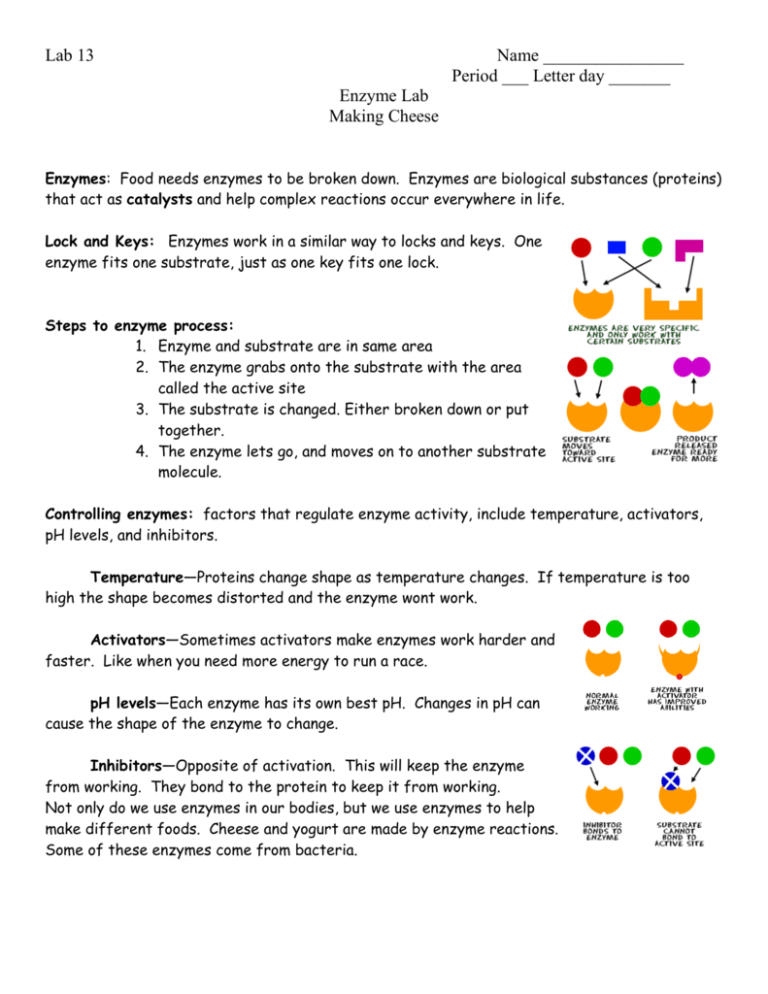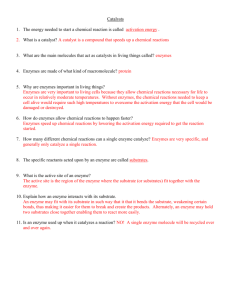Enzyme Lab.doc
advertisement

Lab 13 Name ________________ Period ___ Letter day _______ Enzyme Lab Making Cheese Enzymes: Food needs enzymes to be broken down. Enzymes are biological substances (proteins) that act as catalysts and help complex reactions occur everywhere in life. Lock and Keys: Enzymes work in a similar way to locks and keys. One enzyme fits one substrate, just as one key fits one lock. Steps to enzyme process: 1. Enzyme and substrate are in same area 2. The enzyme grabs onto the substrate with the area called the active site 3. The substrate is changed. Either broken down or put together. 4. The enzyme lets go, and moves on to another substrate molecule. Controlling enzymes: factors that regulate enzyme activity, include temperature, activators, pH levels, and inhibitors. Temperature—Proteins change shape as temperature changes. If temperature is too high the shape becomes distorted and the enzyme wont work. Activators—Sometimes activators make enzymes work harder and faster. Like when you need more energy to run a race. pH levels—Each enzyme has its own best pH. Changes in pH can cause the shape of the enzyme to change. Inhibitors—Opposite of activation. This will keep the enzyme from working. They bond to the protein to keep it from working. Not only do we use enzymes in our bodies, but we use enzymes to help make different foods. Cheese and yogurt are made by enzyme reactions. Some of these enzymes come from bacteria. Cheese making Introduction Procedure: 1. 2. 3. 4. Warm the whole milk to about 32°C (85°to 90°F) on the hot plate fill plastic cup about half full with the warmed milk. Immediately add 1 ml of the rennin solution. Mix well with a stirring stick. Allow the mixture to sit undisturbed until the end of the class period. Cover with plastic wrap and Place cup in refrigerator until next lab period. Next class Period 1. Get your cup from refrigerator. 2. Separate the curds (solid white masses) from the whey (remaining liquid) by filtering the mixture trough two pieces of cheesecloth over a sink or container. 3. Allow the whey to drain from the curd for a few minutes. Gently squeeze the curd to remove excess moisture. If you wish, you may now taste the cheese (you may wish to add some salt) or you can add salt, rewrap the cheese, and set it aside to harden. As you are waiting for each step you should complete the questions below. 1. What do enzymes act as in a reaction? 2. What are enzymes made of? 3. Why is an enzyme reaction called a lock and Key reaction? 4. What 4 things affect the way an enzyme works? 1. 2. 3. 4. 5. What are the 4 steps in an enzyme reaction? 1. 2. 3. 4. 6. List all the materials you needed to make the cheese. 7. Why did we heat the milk to a specific temperature, before adding the enzyme? 8. What would happen if the milk was too hot? 9. What would happen if acid was added to the milk, before you added the enzyme? 10. Design an experimental set up that would test the effects of temperature on the rate of cheese formation. Use the lab report sheet supplied. 20pts Take lab quiz (50 pts)









